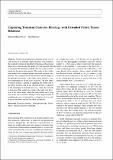| dc.contributor.author | Rojas Parra, Eduardo | |
| dc.contributor.author | Kamrin, Kenneth N | |
| dc.date.accessioned | 2020-11-24T17:30:13Z | |
| dc.date.available | 2020-11-24T17:30:13Z | |
| dc.date.issued | 2019-08 | |
| dc.date.submitted | 2019-03 | |
| dc.identifier.issn | 1434-7636 | |
| dc.identifier.uri | https://hdl.handle.net/1721.1/128625 | |
| dc.description.abstract | We present an improved continuum model for transient processes in granular simple shearing, which predicts the coupled evolution of the effective friction coefficient and fabric tensor. Specifically, the model gives the transient strength associated to the kinematics and the structure of the granular media for the quasi-static regime. The results of the continuum model were compared against molecular dynamic simulations. The comparison for the modulus and the angle of the principal directions of the fabric tensor showed a very good agreement for all the cases analyzed. The new fabric evolution model is capable of capturing the abrupt fall in the fabric modulus and in the effective friction coefficient at the beginning of reversal processes, when the network is destroyed. The model also predicts the right spin direction of the fabric angle, when the force chains move from one steady state to another, during reversal. Improvement in modeling the stress is obtained by relating the friction coefficient to the fabric and the unit shear rate tensors. ©2019, Springer-Verlag GmbH Germany, part of Springer Nature. | en_US |
| dc.description.sponsorship | NSF Grant (CBET-1706193) | en_US |
| dc.language.iso | en | |
| dc.publisher | Springer Science and Business Media LLC | en_US |
| dc.relation.isversionof | https://dx.doi.org/10.1007/S10035-019-0948-9 | en_US |
| dc.rights | Creative Commons Attribution-Noncommercial-Share Alike | en_US |
| dc.rights.uri | http://creativecommons.org/licenses/by-nc-sa/4.0/ | en_US |
| dc.source | Other repository | en_US |
| dc.title | Capturing transient granular rheology with extended fabric tensor relations | en_US |
| dc.type | Article | en_US |
| dc.identifier.citation | Rojas Parra, Eduardo and Ken Kamrin, "Capturing transient granular rheology with extended fabric tensor relations." Granular Matter 21, 4 (August 2019): 89 doi. 10.1007/s10035-019-0948-9 ©2019 Authors | en_US |
| dc.contributor.department | Massachusetts Institute of Technology. Department of Mechanical Engineering | en_US |
| dc.relation.journal | Granular Matter | en_US |
| dc.eprint.version | Author's final manuscript | en_US |
| dc.type.uri | http://purl.org/eprint/type/JournalArticle | en_US |
| eprint.status | http://purl.org/eprint/status/PeerReviewed | en_US |
| dc.date.updated | 2020-07-21T18:44:09Z | |
| dspace.date.submission | 2020-07-21T18:44:11Z | |
| mit.journal.volume | 21 | en_US |
| mit.journal.issue | 4 | en_US |
| mit.license | OPEN_ACCESS_POLICY | |
| mit.metadata.status | Complete | |
